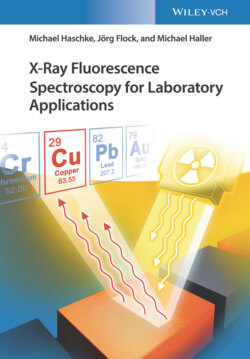Читать книгу X-Ray Fluorescence Spectroscopy for Laboratory Applications - Michael Haschke, Jörg Flock - Страница 16
2.2.4 Interaction of X-rays with Matter
ОглавлениеX-radiation interacts with matter – it will be scattered and absorbed. This process is described by Lambert–Beer's law.
(2.5)
with
| I | intensity after absorption in a layer |
| D | thickness of the layer |
| P | density of the layer |
| M | mass attenuation coefficient of the layer material |
| I 0 | primary intensity |
The mass attenuation coefficient μ has several contributions. At low energies, the absorption described by the photoionization coefficient τ is dominant; the influence of the scattering characterized by the scattering coefficient σ increases with energy, and in the case of energies >1.2 MeV the electron pair production described by κ gains importance. However, this is outside the range of energy that is of interest for X-radiation.
(2.6)
All these interactions depend on both the analyzed material and the energy of the radiation, as shown in the diagrams in Figure 2.5 for the elements (a) carbon and (b) lead. They show that in the energy range of about 0.5–40 keV, absorption dominates. Rayleigh scattering contributes a fraction of less than 1% for low energies. At higher energies, Compton scattering dominates the radiation attenuation coefficient.
